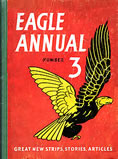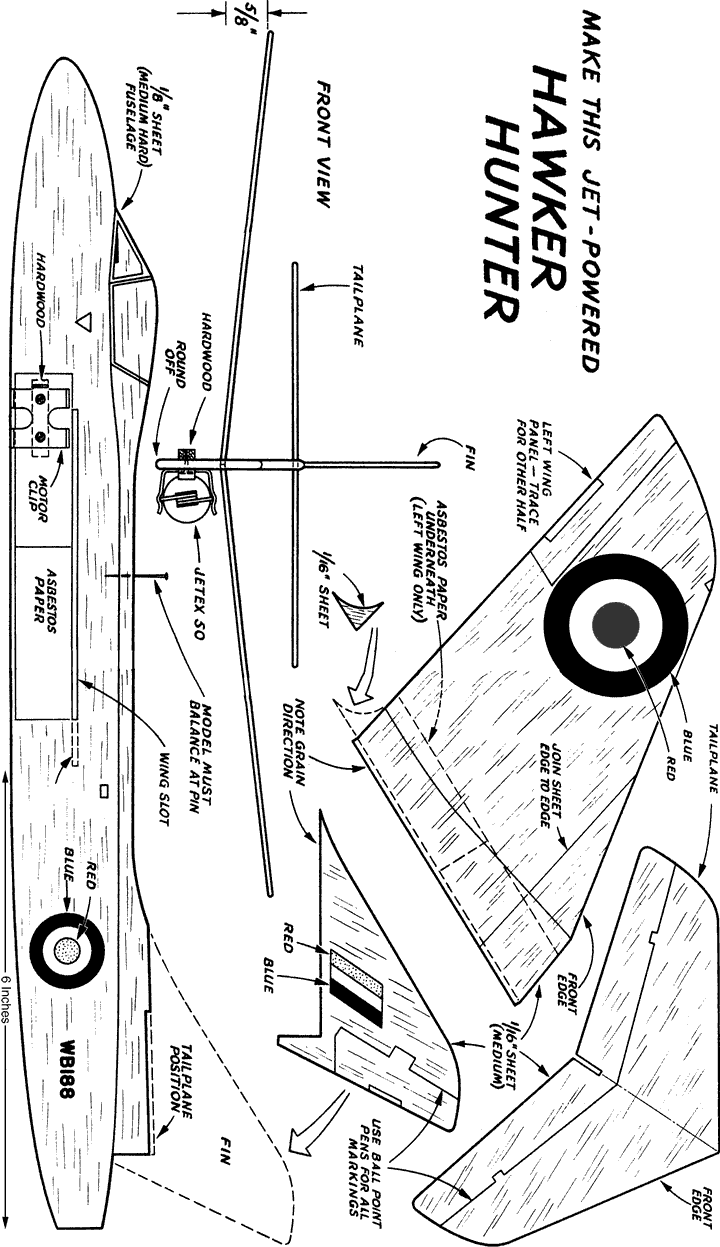|
Hawker Hunter

 by Bill Dean
by Bill Dean
Reprinted from Eagle Annual 3, 1952
This Jetex 50 powered flying model of the famous Hawker Hunter takes just a single evening to build. Start by tracing the parts on to sheet balsa and then cut them out with a sharp razor blade – using a ruler as a guide for the straight cuts. The cockpit, R.A.F. markings and control surface outlines may be marked on the wood with coloured ball-point pens before the model is assembled. Round off the fuselage corners with sandpaper (except at tailplane position) and cement a 1" × ¼" × ¹/8" piece of hardwood to one side (see front and side views). Cement asbestos paper – contained in Jetex 50 outfit – to the other side and screw the motor clip in position.
Round off the edges of the flying surfaces (except wing and fin roots). Sand wing roots to slight angle and cement together – pinning one panel down flat and packing up the other 1 ¼" at the tip. When dry, slide wing into slot in fuselage and well cement, after carefully checking for correct alignment. Add small ‘X’ fairing pieces. Now cement tailplane to fuselage, followed by fin. Push a pin into the fuselage as indicated, attach the loaded motor and check that the model balances level. Drawing pins may be pushed into the nose or tail to obtain correct balance.
Glide test the model on a calm day – gently launching from shoulder height and noting if it dives or ‘stalls’. Correct a nose dive by removing weight from the nose or adding it to the tail. If the model’s nose rises abruptly and then falls (stalling), add more nose weight. A turn in either direction is required, but if the model turns too sharply correct by pushing a drawing pin into the wing tip on the outside of the turn. When satisfied with the glide, ignite the charge, wait several seconds for thrust to develop, then launch on an even keel. Choose a space clear of trees and buildings as the model is capable of long duration flights of up to a quarter of a mile.
|
|
 |

Two ways to get the Hawker Hunter plan:
|
 |
 |
 |
Easy, but smaller
Print this page. At the bottom, and fitting within the page width, is a dimensioned
copy of the plan, set to print at the original size.
(Read more about print sizes >>)
|
 |
 |
More work for you, but larger
Click this link
to a separate dimensioned copy, set to print as a full-size plan.
(Read more about print sizes >>)
If you want to print it in full, you'll need to save it to disk, then open it in a graphics
program in order to print it.
|
 |
|

